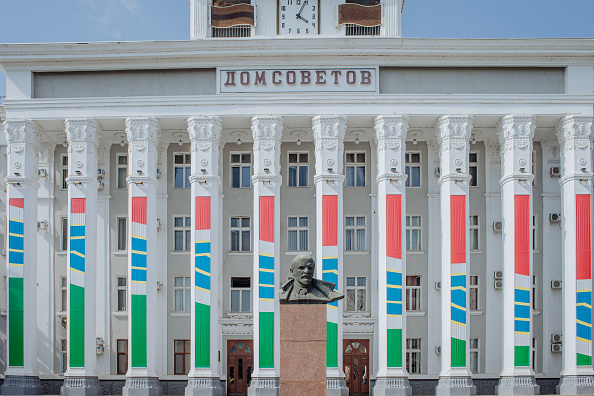When the Luna-25 probe entered Moon orbit last week, the global headlines were reminiscent of the old US-Soviet space race during the Cold War. Here were the Russians, once again reaching for scientific space glory and seeking to demonstrate their technological prowess at a time of high tensions and conflict on Earth. It wasn’t just the mission’s own pedigree that carried memories of times past – Luna-25’s origins go back over 30 years to the end of the USSR – but also the high-risk symbolism wrapped around it.
The bet didn’t come off: the probe crashed into the Moon on Monday, underscoring the parlous state of Russia’s space exploration programme. As AstroAnalytica’s John Sheldon put it in these pages, Luna-25 was likely the “last hurrah” of a once-mighty scientific space power, “a Potemkin space mission” that tried, and failed, to mask the grim state of the country’s civil space endeavours.
It is no wonder that echoes of the Cold War are increasingly present in contemporary discourse. With the international system now experiencing profound geostrategic transformations, the old post-WW2 struggle between the capitalist Free World and the Soviet-led communist bloc has become a favoured term of comparison and framework for making sense of our world today – but this time around with the People’s Republic of China, rather than the USSR, embodying the “evil empire”.
No less of an eminent figure than historian Niall Ferguson has embraced the notion that a Second Cold War is now underway, centred on the US-China rivalry. That the Sino-American relationship is likely the single most consequential aspect of 21st century geopolitics can hardly be contested, given the economic, military and technological weight of each of these two giants.
But the claim that the increasingly fraught dynamic between them and their respective friends and allies amounts to a new Cold War is not just mistaken: through the false assumptions that it contains, it is positively dangerous for our capacity to think clearly about the real nature of today’s geopolitical challenges.
Firstly, at the heart of the Cold War was the implacable and ferocious ideological struggle between capitalism with its liberal-democratic values and communism with its murderous totalitarian horrors. There is no equivalent ideological primacy today. China remains in the grip of a communist, totalitarian political party, but its rise to global prominence has been powered to a large degree by capitalist principles and methods – albeit with Chinese characteristics – and indeed by Western capital.
Secondly, unlike in the Cold War, the world economy is no longer split into separate systems – of free market and command economies – but is now globalised, which makes a crucial difference. The increased use of sanctions, trade wars and “de-coupling” policies are still a relatively recent phenomenon, and are all technically reversible; the institutional foundations of the post-1991 globalised economic system remain essentially liberal in terms of rules for economic flows and interactions. China itself has benefited from – and indeed, gamed – the World Trade Organisation to become the largest trading power on Earth.
Thirdly, there is no equivalent today of the conventional and nuclear stand-off between the two huge multi-national military blocs, NATO and the Warsaw Pact, that defined the military balance during the Cold War. Today the military calculus is much more diffuse, on account of new types of military technologies but also of a more diverse multiplicity of capable intermediate military powers – especially since the NATO Treaty does not cover an Indo-Pacific contingency.
The most strategically significant military posturing is over Taiwan, but there the political and strategic circumstances – including the very question of who would actually enter the fight in an emergency – are more confused and vastly different from the old stand-off over the German plain.
Importantly, the nuclear dimension of the military balance today – which has not received much attention over the past 30 years – is much less pronounced than in the Cold War, and certainly does not yet shape Sino-American strategic relations in the way that the US and Soviets experienced it.
Linked to the proposition of a Second Cold War is the effort, led by China and Russia, to create an alternative to the Western-dominated system of international and regional organisations, institutions and partnerships.
In some interpretations, these various initiatives, connected as they are by shared geopolitical interests and a sense of rivalry and competition with the West, can be viewed as a parallel to the old opposition between the Communist bloc and the Free World.
The list of these alternative groupings has been growing over the years, from the Russian-led CSTO (Collective Security Treaty Organisation) and EEU (Eurasian Economic Union) to the China-led SCO (Shanghai Cooperation Organisation) or AIIB (Asian Infrastructure Investment Bank), plus subsidiary pacts and agreements such as RCEP (the Regional Comprehensive Economic Partnership) or the various components under the BRI (Belt and Road Initiative). There is also the more recent and little-discussed INTSC (International North-South Transport Corridor), a trade route and infrastructure project connecting Russia to India via Iran and Azerbaijan.
But the “shining star” of this collection of so-called “Global South” projects is BRICS, the grouping of Brazil, Russia, India, China and South Africa, whose 2023 summit took place this week in Johannesburg to an unprecedented level of global media attention. Seen by many to mimic the G7 in its general political and economic-coordination function – the flagship objective in the financial realm is the collective fight of Russia, China & Co. against the US dollar – BRICS is also set to expand its membership.
Naturally, its nominal weight in global statistics such as shares of global GDP, population or landmass will also grow with the mooted addition of Saudi Arabia, Iran, Egypt, UAE and Argentina to the club’s membership.
There is no question that, viewed as a totality, all these organisations, institutions and forums involving almost exclusively non-Western countries, crowned by the BRICS format, do amount to a notable and increasingly coherent geostrategic challenge – at least on paper. But is this “rebel network”, with its revisionist agenda directed at overthrowing Western dominance in the international system, comparable to the old threat of world revolutionary communism, backed by Soviet arms and real anti-colonial movements, from the heyday of the Cold War?
Enemies of the West who are excited about the BRICS’ prospects, as well as our homegrown defeatists and declinists, like to point to the BRICS overtaking the G7 in terms of global GDP share at purchasing power parity (32.1 per cent vs 29.9 per cent respectively, in 2023).
Yet in terms of nominal GDP, G7 nations’ economies amount to a combined $46 trillion this year, while BRICS account for a mere total of $27.7 trillion. In other words, even by the single crude measure of nominal GDP, the ($25 trillion) US economy alone is almost as large as all the BRICS put together.
As to the cumulative value of the “rebel network’s” alternative global system-building, it is mostly a matter of theoretical potential for the future – similarly to the grand aim of global “de-dollarisation”. There is much heat and very little light coming out of these diplomatic activities run from Moscow, Beijing, Tehran, Pretoria, Cairo and other “Global South” capitals.
The fact is that institution-building and effective diplomacy that achieves enduring results through trust and relationships requires great political and diplomatic skill and experience, and especially time.
This is true even among culturally-similar and broadly like-minded nations such as those of the Euro-Atlantic community, let alone when dealing with partners from different continents, often with comparatively limited national heritage in the field of international statecraft as co-creators of new institutions rather than followers and users of a Western-made system.
China – and presumably Russia, to the extent that it will be able to continue to play a major role on the world stage in future decades – would no doubt achieve some results with these global revisionist strategies and “rebel networking” in the international community, if given enough time and space by a still-dormant Western leadership.
For now, this earnest anti-Western political work amounts more to a tower of Babel – that will be increasingly more difficult to manage and coordinate as more third-world countries are thrown into the mix – than to a solid, long-term strategic proposition.
The edifice is rickety, as the various players are in it mostly out of opportunism, and some run increasingly high risks of falling between two stools. The most egregious example is India, which on the one hand purports to work with the US, Japan and Australia in the Quad alliance against China, but on the other hand joins with China to undermine the dollar and supports Russia with oil purchases among other things.
There is, therefore, no clear sense in which the outlook of world affairs today could be described in terms of a Cold War, implying a bipolar distribution of power.
Nor has so-called “multipolarity” arrived, as long as the foundations of the global system, built in the West’s image, still stand – and as long as economic, military and technological advantage still lies with the Western alliance. America’s post-Cold War unipolar moment is likewise long gone, buried in the sands of the Middle East.
What we have in front of us, instead, is a moment of opportunity when the structures of world order have become malleable again and can be remodelled. All that is needed is strategic vision.






